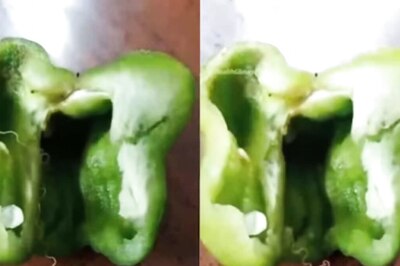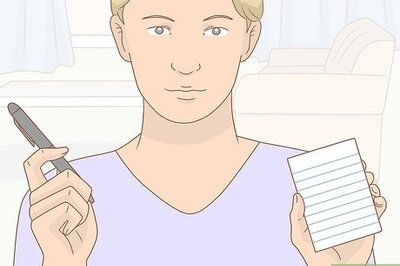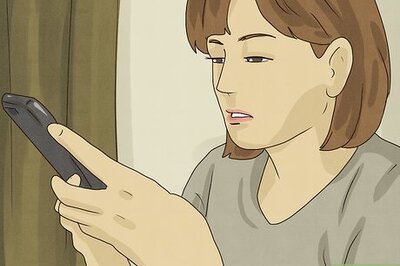
views
Achieving a Taper Fade Mullet Hairstyle
Consider dampening your hair with a spray bottle of water. It’ll be easier to get a precise cut with damp—but not soaking wet—hair. Once you’ve sprayed the hair, comb your hair so that the water saturates it. However, some stylists prefer to cut dry hair, since it’ll give you a better idea of what the cut will look like after it’s done. We recommend asking a stylist to give you this look. You can get a fade mullet at home, but it’ll take LOTS of trial and error, so make sure you’re prepared for your hair to not look how you want at first.
Use hair clips to section off the hair you don’t want to fade. Depending on how high or low you’d like your fade to start, clip off the hair on top of your head to ensure you don’t buzz it. Clip the hair on the crown of your head only to get a fade that starts high, or clip your hair lower and closer to your ear for a fade that starts lower and leaves more hair on top. Try to ensure the line separating the clipped from unclipped hair is clean—this will give you the cleanest possible fade. We recommend standing in front of a mirror and using a handheld mirror to see the back of your head while you do this.
Use clippers to buzz the unclipped hair, stopping just behind your ears. To start your taper fade, we recommend using adjustable electric clippers with a #3 guard lever open to give you the longest possible haircut length—usually about ⁄8 inch (0.95 cm) or so. Buzz all of the unclipped hair, stopping just behind your ear, to debulk your hair and make it easier to get the fade you want. In a non-mullet fade, you’d typically buzz all the way around the back of your head, but for a mullet, you want to leave your hair longer in the back.
Check for obvious fade lines and smooth them with the clippers. Use a handheld mirror to check the fade lines and make sure they’re not obvious. The fade should be seamless, so if you notice distinct lines demarcating where you changed clipper guard levels, use your clippers to gently smooth out the lines and make them less noticeable. Lower the lever positions as you go to create a smooth transition. Once you’ve gotten the fade mullet, you’ll likely need to touch up your fade every 2–4 weeks to maintain the look.
Set your clipper guard to the next number down, then buzz a new layer of hair. If your clipper guard is set to #3, set it to #2 and begin buzzing your unclipped hair a little below (say ⁄2 inch (1.3 cm)) where you first buzzed; this way, the hair immediately below the clipped hair will be slightly longer. Hold the clippers vertically and gently sweep them upwards and off your head, in a scooping motion. Go slowly and carefully to make sure you’re not cutting off too much hair.
Keep adjusting your clipper and buzzing until you get the look you want. Set your guard to the next number down (so if you were just at a #2, go to #1) and start buzzing immediately below where you just buzzed to add to the fade. After you’ve created a new layer, smooth out the fade line again. You can also give yourself a fade in the reverse direction: begin with your clippers set to a lower number, but don’t buzz your hair quite as high. Change your clipper guard to the next number up and buzz a little higher. Keep doing this to give yourself layers.
Use thinning shears to blend the rest of your hair into your fade. Take a comb and pull it through the first few layers of hair above the part line. Then, take a pair of thinning shears and use it to trim this hair to thin it out, so that the transition from the mullet (the hair on top of your head) to the fade on the sides is smoother.
Types of Mullet Fade Haircuts
Fade mullet The OG fade, with a classic mullet. With this look, the hair length decreases dramatically from the top of the head to the sides and back. This cut is great if you have thick hair and want an easy-to-manage hairstyle.
Drop fade mullet This fade usually starts near your eyebrow and drops down behind the ears before running around the back of the head. You can ask for a low skin fade or mid skin fade to tailor this cut a little more specifically: a low skin fade will show roughly and inch or less of skin above the natural hairline, and a mid skin fade will show a bit more skin.
Taper fade mullet In this less dramatic version of the original fade, the hair gradually tapers down to the hairline and fades to show skin only at the temples and the nape of the neck. You can talk to your stylist about how much skin you want to show—it usually varies from low to medium to high—but in all versions of this fade, the hairline remains behind the ear. This cut is also sometimes called the temple fade, Brooklyn fade, or blowout fade, depending on your location. This look is great for folks who want a more classic look, since it’s less dramatic than the original fade. But it’s still just as trendy as the OG fade or burst fade—basically, you get the best of both worlds here.
Burst fade mullet The burst fade is a more dramatic fade than the OG. It’s cut in a semicircle shape around your ear, then the fade drops behind the ear and ends on the side of the neck, and doesn’t continue along the nape of the neck like a low skin or mid skin fade would. This cut gives the longer hair on top of your head a “bursting” effect.
Asking Your Stylist for a Taper Fade Mullet
Be as descriptive as possible about what you want. Tell them you want a “taper fade mullet” (or a “temple fade mullet,” “Brooklyn fade mullet,” or “blowout fade mullet,” if they’re not sure what a taper fade is). But don’t just stop there: review the different variations on the fade mullet so you can be as explicit as possible about what you want. How high do you want your fade to be? Do you want it to be severe, or more seamless? Also consider the vibe you’re going for: something more extreme and eye-grabbing? Or something a little more classic and clean? Say something like, “I want a mullet with a low taper fade on the sides, but keep the top and back hair around [desired length] long.” Or, “Can I get a modern mullet, but with a clean taper fade blending into the back?”
Rely on their expertise. Be as specific as possible about the look you’re going for—but also remember that your stylist is a professional, and if they’re worth their salt, they’ll be familiar with current trends and they’ll know which cuts will look best on you. So if you know you want a taper fade mullet but aren’t sure how low you want the fade or how long you want the rest of your hair, ask for their advice. “I’d like a taper fade mullet, but I don’t know how low the fade should be or how short my hair on top and in back should be—what do you think would look best with my hair?” Also consider the amount of upkeep you’d like involved. For instance, if you have thicker hair, a mullet with shorter hair on top and in back and a higher fade may involve less maintenance. Ask your stylist what cuts they recommend for your needs.
Bring in visual references. Try to find photos and videos of people with the hairstyle you’re aiming for and bring them to your hair appointment to show the stylist. And, if you can, look for references featuring people whose hair is close in texture, length, and color to yours, since not every cut will look the same on everyone. When it comes to choosing a hairstyle, professional makeup artist and hair stylist Frankie Sanderson advises considering which style will look best with your hair’s texture and color: “A lot of times people will look at a picture and think, I want that... because the model is attractive or the haircut looks attractive on the model, and they don't actually take into consideration that their hair texture doesn't look like that at all or their hair color isn't like that.”



















Comments
0 comment